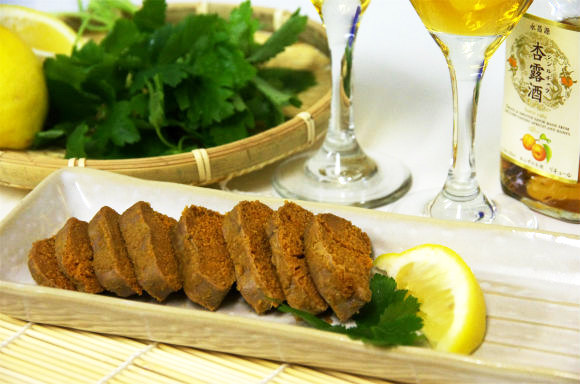
You may think it’s crazy to voluntarily eat poisonous fish, but in the case of pufferfish, or “fugu” in Japanese, it’s something the Japanese have been doing for a long time. We understand how the idea of eating a potentially deadly poisonous fish could be off-putting to some, but most Japanese people wouldn’t think twice about going to a restaurant and having pufferfish; in fact most of us would welcome it as a treat, as a full-course fugu meal usually doesn’t come cheap. Well, this time, we have a story from one of the reporters at the Pouch website about an unusual way to have pufferfish, and this is definitely a recipe you won’t be able to recreate at home!
Typically, thinly sliced sashimi or a hot pot (“fugu-nabe“) in which pieces of fugu are cooked in a pot of boiling water with a variety of vegetables, would be some of the standard ways to eat fugu in Japan. In this instance, however, the reporter had the opportunity to mail order a unique dish of fugu ovaries, and she shares her experience with us. The following is her account:
[My Encouter with Mail Order Fugu Ovaries]
Apart from the Chinese, the Japanese may well be one of the people most obsessed with food in the world. Both the Chinese and Japanese are known for turning the unlikeliest of ingredients into food (provided they actually taste good). I mean,who else in the world other than the Japanese would try to eat fish that is known to be deadly poisonous? If you stop and think about it, it’s amazing that we eat fugu at all, but fugu ovaries? Talk about going far for an eating experience!
So, are the ovaries in pufferfish not poisonous? Actually, they are – they contain plenty of tetrodotoxin, which means that if you eat the ovaries without properly preparing them, you are likely to meet a highly undesirable demise involving your muscles becoming paralyzed and then becoming unable to breathe, all the while staying fully conscious. Hence, the comment about not being able to recreate this dish at home. (Again, DO NOT think about making anything resembling this dish on your own.)
So, you have to be wondering, how do they get rid of the poison from the ovaries? The answer is, they immerse the ovaries in rice bran paste or salt and leave them sitting for a few years, and somehow enzymes work to break down the poison. The actual science behind the process is not fully known. (Okay, this is where you place absolute trust in the chef.)
This particular dish has actually been consumed locally for hundreds of years since the Edo Period, and currently, only specifically licensed manufacturers in select areas, mainly Hakusan and Kanazawa City in Ishikawa Prefecture, are allowed to make the product. It’s quite possible that many unfortunate souls fell victim to the poison before the proper preparation technique was established. Now, people can of course consume the dish without fear of being poisoned, but at one point the Japanese government apparently tried to ban the making of the product, because the scientific process which removes the poison was not absolutely clear. So, in fact, the manufacturers have had to struggle to continue creating this delicacy.
As it so happens, I had previously sampled a similar dish of fugu ovaries pickled in rice bran paste (“nuka-zuke“) when visiting Sado Island in Niigata Prefecture and had become a big fan of the dish. I was wishing I could have fugu ovaries again, when I found out that they were available by mail-order. I only wish I had found out sooner!
▼The fugu ovaries the reporter previously had in Niigata
So, to get my hands on some fugu ovaries, I ordered a product called “Fuguko Nuka-zuke” (Pufferfish Eggs Pickled in Rice Bran Paste) from the shop “Arayo Shoten” based in Mikawa of Hakusan City in Ishikawa Prefecture. Being such a unique product made only by select manufacturers, I was surprised that it was available at a relatively reasonable price of 840 yen ($10.50).
▼The Mail Order Fugu Ovaries from Ishikawa Prefecture 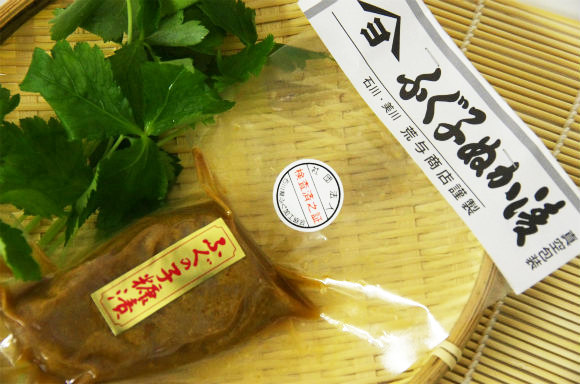
Now, for the highly anticipated tasting of the pufferfish nuka-zuke. These ovaries had been pickled for over 2 years, so not surprisingly, they were quite salty, but the rich flavor of the eggs and the rice bran gradually spread in my mouth and umm… the ovaries were tasty, especially when eaten with freshly cooked white rice! If I was feeling 60% happy before eating the ovaries and rice, I have to say that my level of happiness rose to about 80% afterwards!
And since we girls here at Pouch enjoy a drink or two (or more), we naturally had to try the nuka-zuke with 4 different types of alcoholic drinks. The first drink was a sweet Chinese apricot wine (杏露酒) which we drank with ice in a wine glass – elegant and a perfect drink to reward yourself after a hard day’s work. Then we had some of the nuka-zuke ovaries. Yum, it tastes even better with a squeeze of lemon juice. A sip of sweet apricot wine and a bite of the salty ovaries – wow, they go together so perfectly, we could practically continue doing this forever! Now my happiness level was up to 100%!
▼We tried the fugu ovaries with chinese plum wine.
▼Excellent with a squeeze of lemon juice!
Next, we selected some Japanese sake. We chose 2 brands of sake, the dry-type “Kikusui” (Kikusui no Karakuchi) from Niigata Prefecture where I first had fugu ovaries and “Kaikyo”from Shimonoseki in Yamaguchi prefecture, an area well-known for excellent pufferfish. Considering their area of production, both sakes should go extremely well with fugu!
The dry-type Kikusui had a refreshing taste (which is considered typical of sake from Niigata) that cleansed the salty aftertaste of the nuka-zuke. The Kaikyo also did not disappoint, mellowing the taste of the fugu ovaries with its distinct flavor. Both provided a delightful experience.
▼We tried the fugu with 2 different ypes of sake.
We further arranged the fugu ovaries by having them as a kind of “ochazuke“, which involved placing the fugu on top of rice along with some mitsuba (trefoli plant) and shredded pickled plum, and pouring hot water over the rice and ingredients. (You usually pour Japanese tea over the rice to make ochazuke, but you can also use plain hot water instead, which we did in this instance.) I have to say the ochazuke was incredibly delicious! The flavor of the fugu ovaries mixed with the hot water created an excellent soup and provided just the right amount of saltiness. The pickled plum also added another layer of richness to the taste. This is what I would call heavenly!
▼Making ochazuke with the pickled fugu ovaries
Okay, we thoroughly enjoyed the fugu, but we still wanted to have something more to drink. So, we moved on from sake to white wine – we chose a round Italian wine, the Pasqua Bianco del Veneto. As we imagined, the wine also complemented the nuka-zuke exceedingly well. It was a delightful mix of Japanese and Western flavors. The wine was not too heavy and was the perfect drink to finish off the evening.
▼Fugu with Italian white wine
In the end, we may have had a little too much to drink, but the whole experience was absolute bliss! Needless to say, we girls at Pouch fully intend to continue having more such parties with tasty food and good sake and wine (no matter how much we may regret it in the morning). If you’re willing to brave it, the pickled pufferfish ovaries are a dish we certainly recommend!
Origninal article and photos by: Rinko Meru
▼Some more photos from our memorable night of feasting
[ Read in Japanese ]

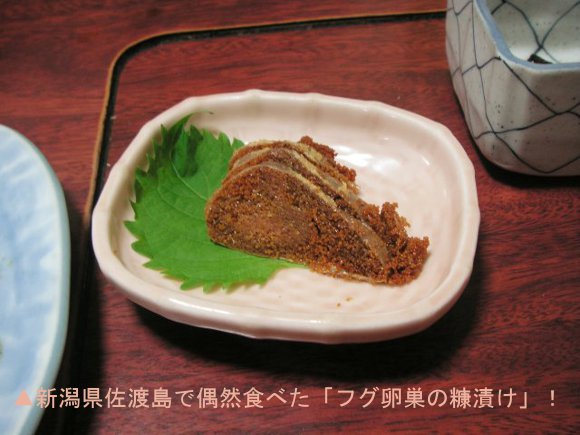
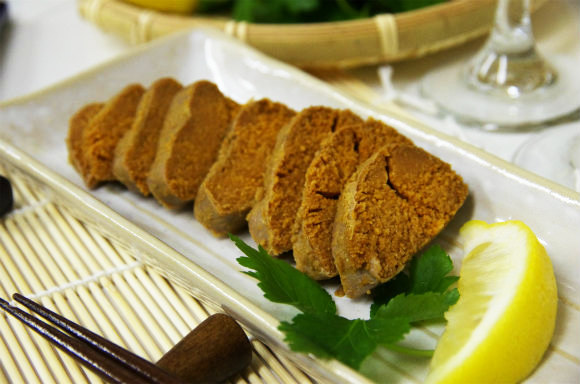

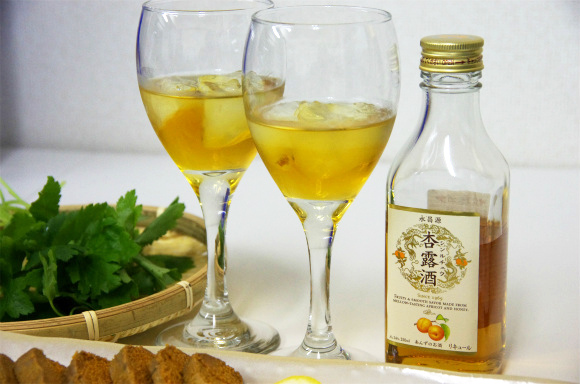
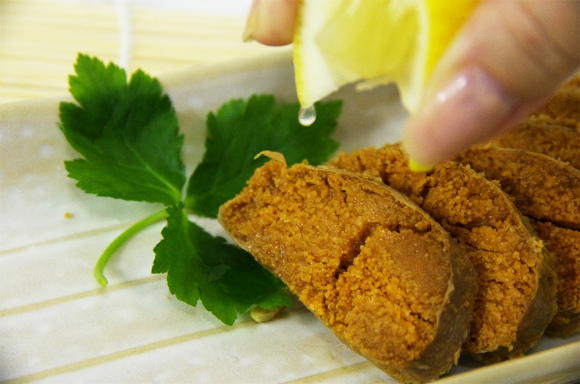
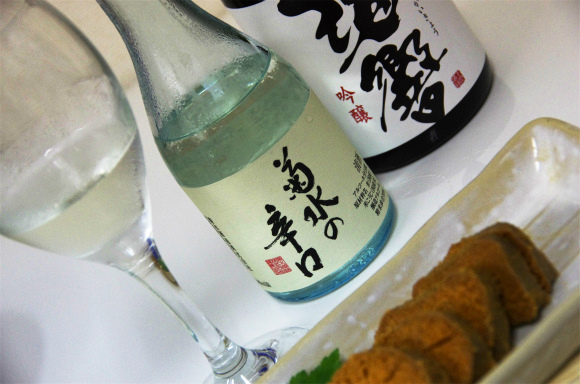
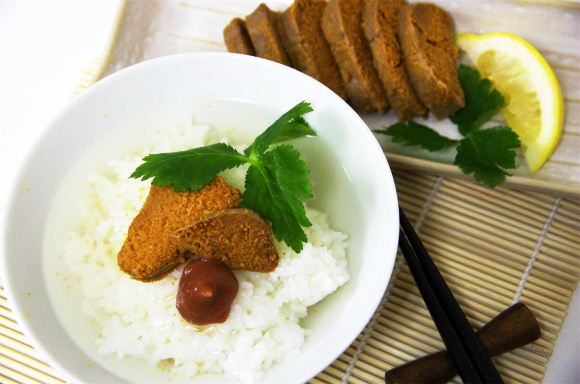
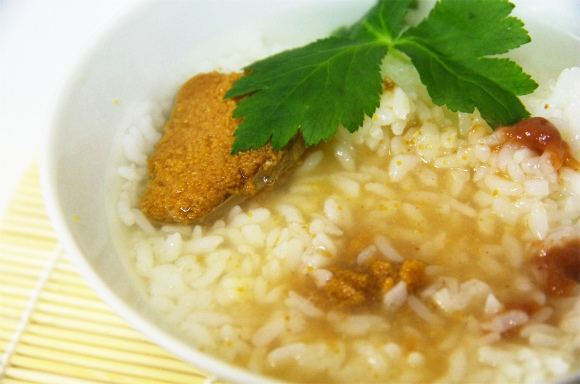
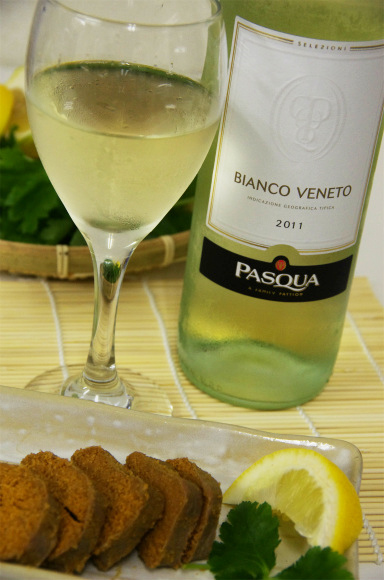
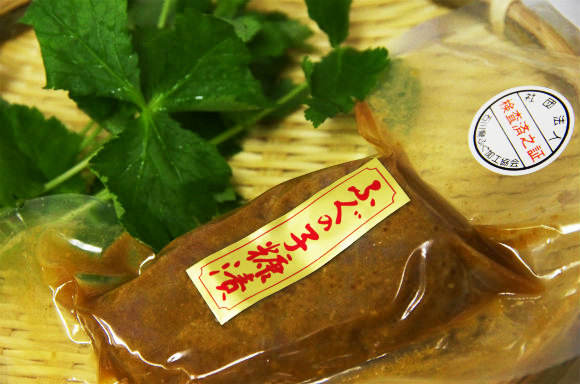
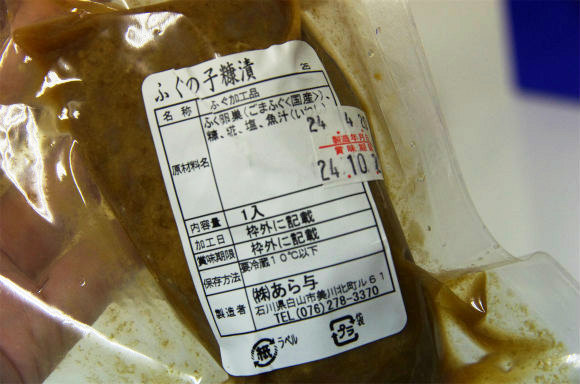
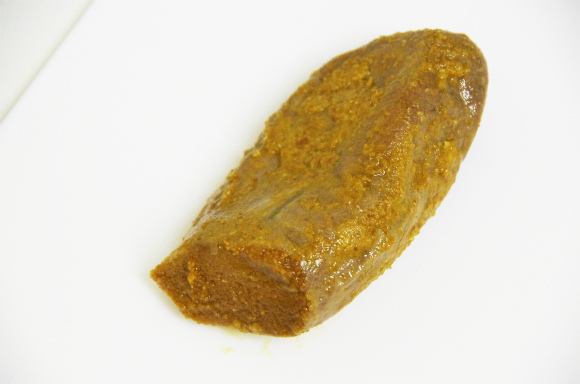
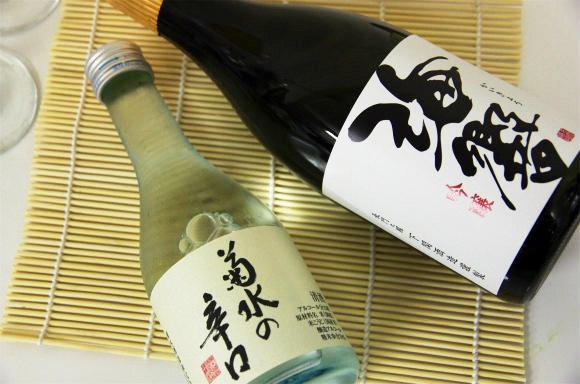
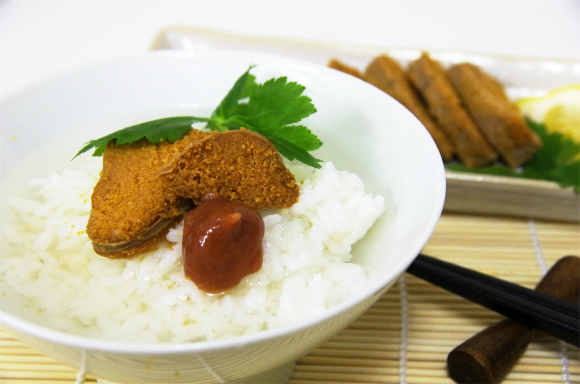
 Poisonous blowfish ramen restaurant in Tokyo is death-defyingly delicious【Taste test】
Poisonous blowfish ramen restaurant in Tokyo is death-defyingly delicious【Taste test】 Aichi supermarket caught selling poisonous puffer fish livers, “been selling it for decades”
Aichi supermarket caught selling poisonous puffer fish livers, “been selling it for decades” You can now get fugu, Japan’s poisonous blowfish, for under a buck at revolving sushi restaurants
You can now get fugu, Japan’s poisonous blowfish, for under a buck at revolving sushi restaurants The secret blowfish auction — trading for deadly but tasty fugu 【Video】
The secret blowfish auction — trading for deadly but tasty fugu 【Video】 Nagoya man hospitalized after eating fish with name including “fugu,” a.k.a. “poisonous blowfish”
Nagoya man hospitalized after eating fish with name including “fugu,” a.k.a. “poisonous blowfish” Foreigner’s request for help in Tokyo makes us sad for the state of society
Foreigner’s request for help in Tokyo makes us sad for the state of society Bad tourist manners at Mt Fuji Lawson photo spot prompts Japanese town to block view with screens
Bad tourist manners at Mt Fuji Lawson photo spot prompts Japanese town to block view with screens McDonald’s Japan’s new pancake pie is a taste sensation
McDonald’s Japan’s new pancake pie is a taste sensation Studio Ghibli unveils massive T-shirt collection featuring top anime movie characters
Studio Ghibli unveils massive T-shirt collection featuring top anime movie characters Two things to do, and two things not to do, when leaving a traditional Japanese inn
Two things to do, and two things not to do, when leaving a traditional Japanese inn FUK COFFEE?!? Japanese cafe has a perfectly innocent reason for its startling-looking name
FUK COFFEE?!? Japanese cafe has a perfectly innocent reason for its startling-looking name One of Japan’s oldest castles now lets travelers spend night on the grounds, drink in its keep
One of Japan’s oldest castles now lets travelers spend night on the grounds, drink in its keep Mikado Coffee is a 76-year-old coffee chain with a major celebrity connection
Mikado Coffee is a 76-year-old coffee chain with a major celebrity connection Japanese ramen restaurants under pressure from new yen banknotes
Japanese ramen restaurants under pressure from new yen banknotes Who wins in a battle of McDonald’s and Komeda Coffee’s chicken tatsuta burgers?【Taste test】
Who wins in a battle of McDonald’s and Komeda Coffee’s chicken tatsuta burgers?【Taste test】 Red light district sushi restaurant in Tokyo shows us just how wrong we were about it
Red light district sushi restaurant in Tokyo shows us just how wrong we were about it McDonald’s new Happy Meals offer up cute and practical Sanrio lifestyle goods
McDonald’s new Happy Meals offer up cute and practical Sanrio lifestyle goods Tokyo Tsukiji fish market site to be redeveloped with 50,000-seat stadium, hotel, shopping center
Tokyo Tsukiji fish market site to be redeveloped with 50,000-seat stadium, hotel, shopping center Japanese city loses residents’ personal data, which was on paper being transported on a windy day
Japanese city loses residents’ personal data, which was on paper being transported on a windy day Beautiful Red and Blue Star luxury trains set to be Japan’s new Hokkaido travel stars
Beautiful Red and Blue Star luxury trains set to be Japan’s new Hokkaido travel stars Ghibli Park now selling “Grilled Frogs” from food cart in Valley of Witches
Ghibli Park now selling “Grilled Frogs” from food cart in Valley of Witches New definition of “Japanese whiskey” goes into effect to prevent fakes from fooling overseas buyers
New definition of “Japanese whiskey” goes into effect to prevent fakes from fooling overseas buyers Our Japanese reporter visits Costco in the U.S., finds super American and very Japanese things
Our Japanese reporter visits Costco in the U.S., finds super American and very Japanese things All-you-can-drink Starbucks and amazing views part of Tokyo’s new 170 meter-high sky lounge
All-you-can-drink Starbucks and amazing views part of Tokyo’s new 170 meter-high sky lounge More foreign tourists than ever before in history visited Japan last month
More foreign tourists than ever before in history visited Japan last month New Pokémon cakes let you eat your way through Pikachu and all the Eevee evolutions
New Pokémon cakes let you eat your way through Pikachu and all the Eevee evolutions Disney princesses get official manga makeovers for Manga Princess Cafe opening in Tokyo
Disney princesses get official manga makeovers for Manga Princess Cafe opening in Tokyo We try out “Chan Ramen”, an underground type of ramen popular in the ramen community
We try out “Chan Ramen”, an underground type of ramen popular in the ramen community Sales of Japan’s most convenient train ticket/shopping payment cards suspended indefinitely
Sales of Japan’s most convenient train ticket/shopping payment cards suspended indefinitely Sold-out Studio Ghibli desktop humidifiers are back so Totoro can help you through the dry season
Sold-out Studio Ghibli desktop humidifiers are back so Totoro can help you through the dry season Japanese government to make first change to romanization spelling rules since the 1950s
Japanese government to make first change to romanization spelling rules since the 1950s Ghibli founders Toshio Suzuki and Hayao Miyazaki contribute to Japanese whisky Totoro label design
Ghibli founders Toshio Suzuki and Hayao Miyazaki contribute to Japanese whisky Totoro label design Doraemon found buried at sea as scene from 1993 anime becomes real life【Photos】
Doraemon found buried at sea as scene from 1993 anime becomes real life【Photos】 Tokyo’s most famous Starbucks is closed
Tokyo’s most famous Starbucks is closed One Piece characters’ nationalities revealed, but fans have mixed opinions
One Piece characters’ nationalities revealed, but fans have mixed opinions We asked a Uniqlo employee what four things we should buy and their suggestions didn’t disappoint
We asked a Uniqlo employee what four things we should buy and their suggestions didn’t disappoint Renting a Girlfriend in Japan: Relationship goals or just plain awkward? 【Video】
Renting a Girlfriend in Japan: Relationship goals or just plain awkward? 【Video】 Osaka loses a beloved icon as giant pufferfish disappears in the middle of the night 【Video】
Osaka loses a beloved icon as giant pufferfish disappears in the middle of the night 【Video】 The next fad for UFO catcher prizes: tiny pufferfish!
The next fad for UFO catcher prizes: tiny pufferfish! The depressing diet of a Tokyo prostitute during Japan’s Edo period
The depressing diet of a Tokyo prostitute during Japan’s Edo period Middle-aged Chinese man’s “stomach pains” turn out to be his first period as a woman
Middle-aged Chinese man’s “stomach pains” turn out to be his first period as a woman Mermaid mummy stored at Japanese temple has true identity revealed after year-long study【Video】
Mermaid mummy stored at Japanese temple has true identity revealed after year-long study【Video】 We try Keiji, an incredibly rare and expensive one-in-ten-thousand salmon sushi 【Taste test】
We try Keiji, an incredibly rare and expensive one-in-ten-thousand salmon sushi 【Taste test】 2,500 yen for Tokyo ramen? High-end noodles in the high-rent Ginza district are totally worth it
2,500 yen for Tokyo ramen? High-end noodles in the high-rent Ginza district are totally worth it Now’s your once-in-12-years chance to order this special $850 pot of pickled plums!
Now’s your once-in-12-years chance to order this special $850 pot of pickled plums! Japan super budget dining – What’s the best way to spend 1,000 yen at Family Mart?
Japan super budget dining – What’s the best way to spend 1,000 yen at Family Mart? Muji’s Nuka Paste for Pickling is perfect for making your own Japanese pickles at home
Muji’s Nuka Paste for Pickling is perfect for making your own Japanese pickles at home Drink Green! We check out the amazing “Green Tea Party” presented by Isetan and Ito En! 【Pics】
Drink Green! We check out the amazing “Green Tea Party” presented by Isetan and Ito En! 【Pics】 Craving cheese but on a diet? Try our “advanced tofu pickles!” 【Recipe】
Craving cheese but on a diet? Try our “advanced tofu pickles!” 【Recipe】 Don’t drink alone! Nine Japanese snacks to accompany sake that you’ve probably never tried
Don’t drink alone! Nine Japanese snacks to accompany sake that you’ve probably never tried What part of Japan has the best food, and what should you eat there?
What part of Japan has the best food, and what should you eat there? Domino’s Japan pushes pickle love to the limit with new Pickles Pizza
Domino’s Japan pushes pickle love to the limit with new Pickles Pizza We try the YU Sparkling Wine, the ultimate wine to pair with sushi
We try the YU Sparkling Wine, the ultimate wine to pair with sushi
Leave a Reply